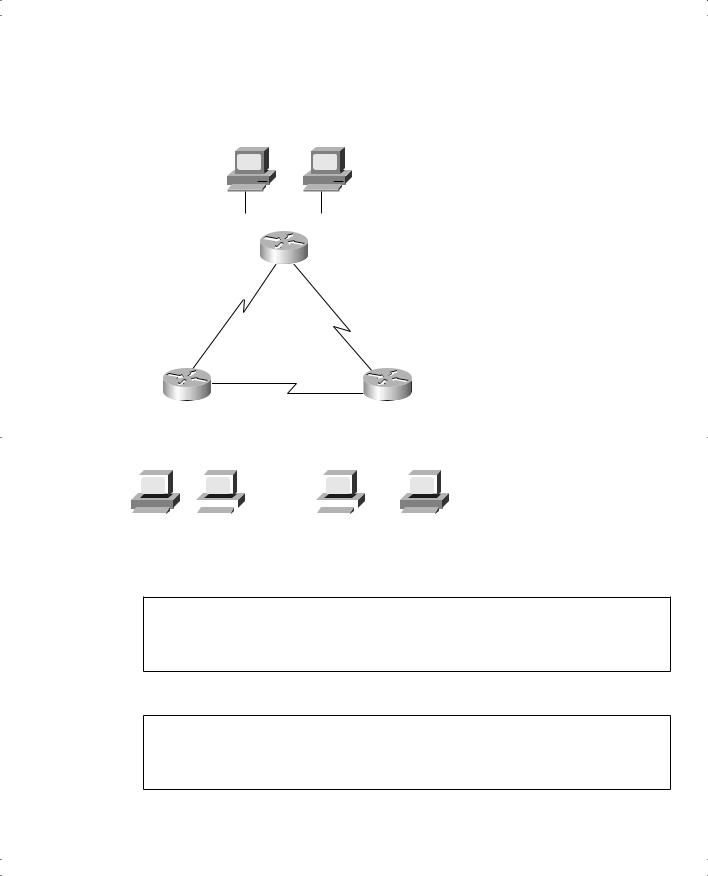
- •Warning and Disclaimer
- •Feedback Information
- •Trademark Acknowledgments
- •About the Author
- •About the Technical Reviewers
- •Dedication
- •Acknowledgments
- •Contents at a Glance
- •Contents
- •Icons Used in This Book
- •Command Syntax Conventions
- •Cisco’s Motivation: Certifying Partners
- •Format of the CCNA Exams
- •What’s on the CCNA Exams
- •ICND Exam Topics
- •Cross-Reference Between Exam Topics and Book Parts
- •CCNA Exam Topics
- •INTRO and ICND Course Outlines
- •Objectives and Methods
- •Book Features
- •How This Book Is Organized
- •Part I: LAN Switching
- •Part II: TCP/IP
- •Part III: Wide-Area Networks
- •Part IV: Network Security
- •Part V: Final Preparation
- •Part VI: Appendixes
- •How to Use These Books to Prepare for the CCNA Exam
- •For More Information
- •Part I: LAN Switching
- •“Do I Know This Already?” Quiz
- •Foundation Topics
- •Brief Review of LAN Switching
- •The Forward-Versus-Filter Decision
- •How Switches Learn MAC Addresses
- •Forwarding Unknown Unicasts and Broadcasts
- •LAN Switch Logic Summary
- •Basic Switch Operation
- •Foundation Summary
- •Spanning Tree Protocol
- •“Do I Know This Already?” Quiz
- •Foundation Topics
- •Spanning Tree Protocol
- •What IEEE 802.1d Spanning Tree Does
- •How Spanning Tree Works
- •Electing the Root and Discovering Root Ports and Designated Ports
- •Reacting to Changes in the Network
- •Spanning Tree Protocol Summary
- •Optional STP Features
- •EtherChannel
- •PortFast
- •Rapid Spanning Tree (IEEE 802.1w)
- •RSTP Link and Edge Types
- •RSTP Port States
- •RSTP Port Roles
- •RSTP Convergence
- •Edge-Type Behavior and PortFast
- •Link-Type Shared
- •Link-Type Point-to-Point
- •An Example of Speedy RSTP Convergence
- •Basic STP show Commands
- •Changing STP Port Costs and Bridge Priority
- •Foundation Summary
- •Foundation Summary
- •Virtual LANs and Trunking
- •“Do I Know This Already?” Quiz
- •Foundation Topics
- •Review of Virtual LAN Concepts
- •Trunking with ISL and 802.1Q
- •ISL and 802.1Q Compared
- •VLAN Trunking Protocol (VTP)
- •How VTP Works
- •VTP Pruning
- •Foundation Summary
- •Part II: TCP/IP
- •IP Addressing and Subnetting
- •“Do I Know This Already?” Quiz
- •Foundation Topics
- •IP Addressing Review
- •IP Subnetting
- •Analyzing and Interpreting IP Addresses and Subnets
- •Math Operations Used to Answer Subnetting Questions
- •Converting IP Addresses from Decimal to Binary and Back Again
- •The Boolean AND Operation
- •How Many Hosts and How Many Subnets?
- •What Is the Subnet Number, and What Are the IP Addresses in the Subnet?
- •Finding the Subnet Number
- •Finding the Subnet Broadcast Address
- •Finding the Range of Valid IP Addresses in a Subnet
- •Finding the Answers Without Using Binary
- •Easier Math with Easy Masks
- •Which Subnet Masks Meet the Stated Design Requirements?
- •What Are the Other Subnet Numbers?
- •Foundation Summary
- •“Do I Know This Already?” Quiz
- •Foundation Topics
- •Extended ping Command
- •Distance Vector Concepts
- •Distance Vector Loop-Avoidance Features
- •Route Poisoning
- •Split Horizon
- •Split Horizon with Poison Reverse
- •Hold-Down Timer
- •Triggered (Flash) Updates
- •RIP and IGRP
- •IGRP Metrics
- •Examination of RIP and IGRP debug and show Commands
- •Issues When Multiple Routes to the Same Subnet Exist
- •Administrative Distance
- •Foundation Summary
- •“Do I Know This Already?” Quiz
- •Foundation Topics
- •Link-State Routing Protocol and OSPF Concepts
- •Steady-State Operation
- •Loop Avoidance
- •Scaling OSPF Through Hierarchical Design
- •OSPF Areas
- •Stub Areas
- •Summary: Comparing Link-State and OSPF to Distance Vector Protocols
- •Balanced Hybrid Routing Protocol and EIGRP Concepts
- •EIGRP Loop Avoidance
- •EIGRP Summary
- •Foundation Summary
- •“Do I Know This Already?” Quiz
- •Foundation Topics
- •Route Summarization and Variable-Length Subnet Masks
- •Route Summarization Concepts
- •VLSM
- •Route Summarization Strategies
- •Sample “Best” Summary on Seville
- •Sample “Best” Summary on Yosemite
- •Classless Routing Protocols and Classless Routing
- •Classless and Classful Routing Protocols
- •Autosummarization
- •Classful and Classless Routing
- •Default Routes
- •Classless Routing
- •Foundation Summary
- •Advanced TCP/IP Topics
- •“Do I Know This Already?” Quiz
- •Foundation Topics
- •Scaling the IP Address Space for the Internet
- •CIDR
- •Private Addressing
- •Network Address Translation
- •Static NAT
- •Dynamic NAT
- •Overloading NAT with Port Address Translation (PAT)
- •Translating Overlapping Addresses
- •Miscellaneous TCP/IP Topics
- •Internet Control Message Protocol (ICMP)
- •ICMP Echo Request and Echo Reply
- •Destination Unreachable ICMP Message
- •Time Exceeded ICMP Message
- •Redirect ICMP Message
- •Secondary IP Addressing
- •FTP and TFTP
- •TFTP
- •MTU and Fragmentation
- •Foundation Summary
- •Part III: Wide-Area Networks
- •“Do I Know This Already?” Quiz
- •Foundation Topics
- •Review of WAN Basics
- •Physical Components of Point-to-Point Leased Lines
- •Data-Link Protocols for Point-to-Point Leased Lines
- •HDLC and PPP Compared
- •Looped Link Detection
- •Enhanced Error Detection
- •Authentication Over WAN Links
- •PAP and CHAP Authentication
- •Foundation Summary
- •“Do I Know This Already?” Quiz
- •Foundation Topics
- •ISDN Protocols and Design
- •Typical Uses of ISDN
- •ISDN Channels
- •ISDN Protocols
- •ISDN BRI Function Groups and Reference Points
- •ISDN PRI Function Groups and Reference Points
- •BRI and PRI Encoding and Framing
- •PRI Encoding
- •PRI Framing
- •BRI Framing and Encoding
- •DDR Step 1: Routing Packets Out the Interface to Be Dialed
- •DDR Step 2: Determining the Subset of the Packets That Trigger the Dialing Process
- •DDR Step 3: Dialing (Signaling)
- •DDR Step 4: Determining When the Connection Is Terminated
- •ISDN and DDR show and debug Commands
- •Multilink PPP
- •Foundation Summary
- •Frame Relay
- •“Do I Know This Already?” Quiz
- •Foundation Topics
- •Frame Relay Protocols
- •Frame Relay Standards
- •Virtual Circuits
- •LMI and Encapsulation Types
- •DLCI Addressing Details
- •Network Layer Concerns with Frame Relay
- •Layer 3 Addressing with Frame Relay
- •Frame Relay Layer 3 Addressing: One Subnet Containing All Frame Relay DTEs
- •Frame Relay Layer 3 Addressing: One Subnet Per VC
- •Frame Relay Layer 3 Addressing: Hybrid Approach
- •Broadcast Handling
- •Frame Relay Service Interworking
- •A Fully-Meshed Network with One IP Subnet
- •Frame Relay Address Mapping
- •A Partially-Meshed Network with One IP Subnet Per VC
- •A Partially-Meshed Network with Some Fully-Meshed Parts
- •Foundation Summary
- •Part IV: Network Security
- •IP Access Control List Security
- •“Do I Know This Already?” Quiz
- •Foundation Topics
- •Standard IP Access Control Lists
- •IP Standard ACL Concepts
- •Wildcard Masks
- •Standard IP ACL: Example 2
- •Extended IP Access Control Lists
- •Extended IP ACL Concepts
- •Extended IP Access Lists: Example 1
- •Extended IP Access Lists: Example 2
- •Miscellaneous ACL Topics
- •Named IP Access Lists
- •Controlling Telnet Access with ACLs
- •ACL Implementation Considerations
- •Foundation Summary
- •Part V: Final Preparation
- •Final Preparation
- •Suggestions for Final Preparation
- •Preparing for the Exam Experience
- •Final Lab Scenarios
- •Scenario 1
- •Scenario 1, Part A: Planning
- •Solutions to Scenario 1, Part A: Planning
- •Scenario 2
- •Scenario 2, Part A: Planning
- •Solutions to Scenario 2, Part A: Planning
- •Part VI: Appendixes
- •Glossary
- •Answers to the “Do I Know This Already?” Quizzes and Q&A Questions
- •Chapter 1
- •“Do I Know This Already?” Quiz
- •Chapter 2
- •“Do I Know This Already?” Quiz
- •Chapter 3
- •“Do I Know This Already?” Quiz
- •Chapter 4
- •“Do I Know This Already?” Quiz
- •Chapter 5
- •“Do I Know This Already?” Quiz
- •Chapter 6
- •“Do I Know This Already?” Quiz
- •Chapter 7
- •“Do I Know This Already?” Quiz
- •Chapter 8
- •“Do I Know This Already?” Quiz
- •Chapter 9
- •“Do I Know This Already?” Quiz
- •Chapter 10
- •“Do I Know This Already?” Quiz
- •Chapter 11
- •“Do I Know This Already?” Quiz
- •Chapter 12
- •“Do I Know This Already?” Quiz
- •Using the Simulation Software for the Hands-on Exercises
- •Accessing NetSim from the CD
- •Hands-on Exercises Available with NetSim
- •Scenarios
- •Labs
- •Listing of the Hands-on Exercises
- •How You Should Proceed with NetSim
- •Considerations When Using NetSim
- •Routing Protocol Overview
- •Comparing and Contrasting IP Routing Protocols
- •Routing Through the Internet with the Border Gateway Protocol
- •RIP Version 2
- •The Integrated IS-IS Link State Routing Protocol
- •Summary of Interior Routing Protocols
- •Numbering Ports (Interfaces)

434 Chapter 12: IP Access Control List Security
ACL 1 keeps packets sent by Bob from exiting R1’s Ethernet interface, based on the matching logic of the access-list 1 deny 172.16.3.10 0.0.0.0 command. The wildcard mask of 0.0.0.0 means “match all 32 bits,” so only packets whose IP address exactly matches 172.16.3.10 match this statement and are discarded. The access-list 1 permit 0.0.0.0 255.255.255.255 command, the last statement in the list, matches all packets, because the wildcard mask of 255.255.255.255 means “don’t care” about all 32 bits. In other words, the statement matches all IP source addresses. These packets are permitted.
The list stops Bob from getting packets to Server1, but it also stops Bob from getting packets to Server2. With the topology shown in Figure 12-1, you cannot use a standard ACL and deny Bob access to Server 1 while permitting access to Server2. You need to use an extended ACL, as discussed in the next section.
Interestingly, IOS changes the configuration shown in Example 12-1. The output of the show running-config command in Example 12-2 shows what IOS actually places in the configuration file.
Example 12-2 Revised Standard Access List Stopping Bob from Reaching Server1
interface Ethernet0
ip address 172.16.1.1 255.255.255.0 ip access-group 1 out
access-list 1 remark stop all traffic whose source IP is Bob access-list 1 deny host 172.16.3.10
access-list 1 permit any
The commands in Example 12-1 are changed based on three factors. Cisco IOS allows both an older style and newer style of configuration for some parameters. Example 12-1 shows the older style, and the router changes to the equivalent newer-style configuration in Example 12-2. First, the use of a wildcard mask of 0.0.0.0 does indeed mean that the router should match that specific host IP address. The newer-style configuration uses the host keyword in front of the specific IP address. The other change to the newer-style configuration involves the use of wildcard mask 255.255.255.255 to mean “match anything.” The newer-style configuration uses the keyword any to replace wildcard mask 255.255.255.255. any simply means that any IP address is matched.
Standard IP ACL: Example 2
The second standard IP ACL exposes more ACL issues. Figure 12-3 and Examples 12-3 and 12-4 show a basic use of standard IP access lists, with two typical oversights in the first attempt at a complete solution. The criteria for the access lists are as follows:
■Sam is not allowed access to Bugs or Daffy.
■Hosts on the Seville Ethernet are not allowed access to hosts on the Yosemite Ethernet.
■All other combinations are allowed.

Standard IP Access Control Lists 435
Figure 12-3 Network Diagram for Standard Access List Example
Bugs Daffy
10.1.1.110.1.1.2
Subnet 10.1.1.0
|
E0 |
|
|
Albuquerque |
|
s0 |
s1 |
|
|
|
|
.128 |
.0 |
|
|
.1 |
|
|
|
10 |
|
|
|
Subnet |
|
|
|
|
|
|
|
|
s0
Subnet
10
. 1 .
130
. 0
s0
|
|
|
|
|
|
|
|
|
|
|
|
|
|
Subnet 10.1.129.0 |
|
|
|
|
|
|
|
|
|
|
|
||||
Yosemite |
|
|
|
|
|
s1 |
s1 |
|
|
Seville |
|||||||||||||||||||
|
|
|
|
|
|
|
|
|
|
|
|
|
|
|
|
||||||||||||||
|
|
|
|
|
|
|
|
E0 |
E0 |
||||||||||||||||||||
|
|
|
|
|
|
|
|
|
|
|
|||||||||||||||||||
|
|
|
|
|
|
|
|
|
Subnet 10.1.2.0 |
|
|
|
|
Subnet 10.1.3.0 |
|||||||||||||||
|
|
|
|
|
|
|
|
|
|
|
|
|
|
|
|
|
|
|
|
|
|
|
|
|
|
|
|
|
|
|
|
|
|
|
|
|
|
|
|
|
|
|
|
|
|
|
|
|
|
|
|
|
|
|
|
|
|
|
|
|
|
|
|
|
|
|
|
|
|
|
|
|
|
|
|
|
|
|
|
|
|
|
|
|
|
|
|
|
|
|
|
|
|
|
|
|
|
|
|
|
|
|
|
|
|
|
|
|
|
|
|
|
|
|
|
|
|
|
|
|
|
|
|
|
|
|
|
|
|
|
|
|
|
|
|
|
|
|
|
|
|
|
|
|
|
|
|
|
|
|
|
|
|
|
|
|
|
|
|
|
|
|
|
|
|
|
|
|
|
|
|
|
|
|
|
|
|
|
|
|
|
|
|
|
|
|
|
|
|
|
|
|
|
|
|
|
|
|
|
|
|
|
|
|
|
|
|
|
|
Sam |
Emma |
Elmer |
Red |
10.1.2.1 |
10.1.2.2 |
10.1.3.1 |
10.1.3.2 |
Example 12-3 Yosemite Configuration for Standard Access List Example
interface serial 0 ip access-group 3 out
!
access-list 3 deny host 10.1.2.1 access-list 3 permit any
Example 12-4 Seville Configuration for Standard Access List Example
interface serial 1 ip access-group 4 out
!
access-list 4 deny 10.1.3.0 0.0.0.255 access-list 4 permit any

436 Chapter 12: IP Access Control List Security
At first glance, these two access lists seem to perform the desired function. ACL 3, enabled for packets exiting Yosemite’s S0 interface, takes care of criterion 1, because ACL 3 matches Sam’s IP address exactly. ACL 4 in Seville, enabled for packets exiting its S1 interface, takes care of criterion 2, because ACL 4 matches all packets coming from subnet 10.1.3.0/24. Both routers meet criterion 3: A wildcard permit any is used at the end of each access list to override the default, which is to discard all other packets. So all the criteria appear to be met.
However, when one of the WAN links fails, some holes can appear in the ACLs. For example, if the link from Albuquerque to Yosemite fails, Yosemite learns a route to 10.1.1.0/24 through Seville. Packets from Sam, forwarded by Yosemite and destined for hosts in Albuquerque, leave Yosemite’s serial 1 interface without being filtered. So criterion 1 is no longer met. Similarly, if the link from Albuquerque to Yosemite fails, Seville routes packets through Albuquerque, routing around the access list enabled on Seville, so criterion 2 is no longer met.
Example 12-5 illustrates an alternative solution—one that works even when some of the links fail.
Example 12-5 Yosemite Configuration for Standard Access List Example: Alternative Solution to Examples 12-3 and 12-4
interface serial 0 ip access-group 3 out
!
interface serial 1 ip access-group 3 out
!
interface ethernet 0 ip access-group 4 out
!
access-list 3 remark meets criteria 1 access-list 3 deny host 10.1.2.1 access-list 3 permit any
!
access-list 4 remark meets criteria 2 access-list 4 deny 10.1.3.0 0.0.0.255 access-list 4 permit any
The configuration in Example 12-5 solves the problem from Examples 12-3 and 12-4. ACL 3 checks for Sam’s source IP address, and it is enabled on both serial links for outbound traffic. So, of the traffic that is rerouted because of a WAN link failure, the packets from SAM are still filtered. To meet criterion 2, Yosemite filters packets as they exit its Ethernet interface. Therefore, regardless of which of the two WAN links the packets enter, packets from Seville’s subnet are not forwarded to Yosemite’s Ethernet.
